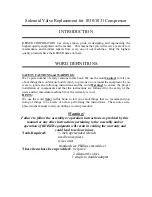
Cleaning Deposit Cup and Fuel Strainer Deposit Cup
1) Push the fuel valve to the closed (left) position.
2) Remove centre deposit cup bolt (B) Fig.17 using a wrench. Place a pan
under the deposit cup to catch any gasoline inside the carburetor.
3) Remove deposit cup (A) Fig.17 and o-ring (C), wash both in solvent.
4) Reinstall parts in reverse order.
Fuel Strainer
1) Remove gasoline tank cap (A) Fig.18 and pull out the fuel strainer (B).
2) Clean fuel strainer in solvent.
3) Reinstall parts in reverse order.
MAINTENANCE SCHEDULE
After initial 20 hours of operation:
Change engine oil.
Every 25 hours of operation thereafter:
Clean/replace air filter. Inspect/clean
spark plug.
Every 100 hours of operation:
Change engine oil. Clean fuel strainer.
Replace spark plug. Replace air filter.
STORAGE
If you plan on storing your engine for an extended period of time, the following
steps should be followed;
1) Add fuel stabilizer to fuel tank to minimize the formation of fuel gum deposits
during storage.
2) Run engine at least 5 minutes after adding stabilizer to allow it to enter the
fuel system.
NOTE:
If a fuel stabilizer is not used, all gasoline must be
drained from the tank and carburetor to prevent gum deposits from forming
on these parts and causing possible malfunction of the engine. To drain
gasoline;
3) Turn fuel shut-off valve (A) Fig.19 to the “OFF” position as shown.
4) Position a drain pan under the carburetor.
5) Remove drain hex. bolt (A) Fig.20 from the carburetor (B) and drain the fuel
from the carburetor and hose.
6) Turn fuel shut-off valve to the “ON” position.
7) Drain fuel from tank.
8) Reinstall the carburetor drain hex. bolt once the fuel is completely drained.
9) Drain engine oil from engine as described in “Engine Oil Replacement”.
10) Gently pull the recoil starter handle to distribute oil into the cylinder, pull
until resistance is felt.
11) Cover and store in a dry, well ventilated area.
Note: To prevent corrosion or moisture build-up during storage, do not cover
the engine with a poly-bag or similar material.
MAINTENANCE
FIGURE 17
FIGURE 18
FIGURE 19
FIGURE 20






























